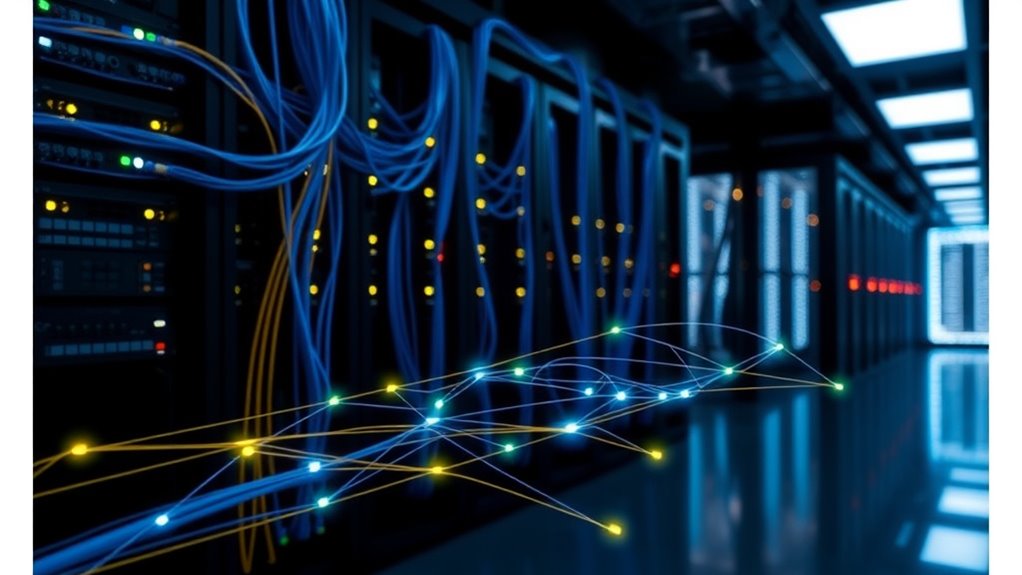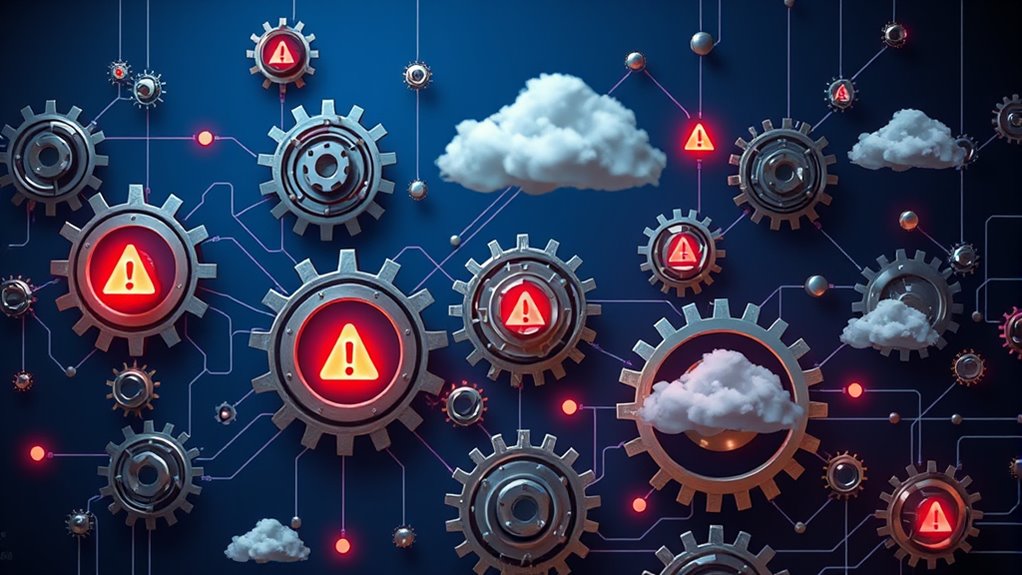iPaaS integration faces five major challenges that organizations must address. Data security and compliance requirements demand robust protection of sensitive information, while managing multiple APIs introduces complexity in handling various protocols. System performance can suffer from data delivery delays and processing bottlenecks, and vendor lock-in poses strategic risks. Cost management remains essential, as unexpected expenses arise from complex implementations and maintenance needs. Understanding these challenges helps organizations develop effective solutions for seamless integration.

Integration Platform as a Service (iPaaS) solutions face numerous challenges that organizations must carefully navigate to guarantee successful implementation and operation. At the forefront of these challenges lies data security and compliance, requiring robust protection of sensitive information both in transit and at rest. Organizations must guarantee adherence to regulations like GDPR and HIPAA while implementing extensive security controls to prevent unauthorized access and potential breaches. Poor implementation of security measures can lead to serious data breaches. Solutions like ApiX-Drive offer robust encryption features to protect data integrity.
The complexity of managing multiple APIs presents another significant hurdle. Integration platforms must handle various protocols and data formats, making the process time-consuming and potentially error-prone. While unified API management platforms offer some relief through standardized formats and pre-built connectors, organizations still need to maintain proper security features and efficient lifecycle management to minimize operational risks. Establishing data governance frameworks helps ensure consistent data handling across integrated systems.
Data delivery delays and processing bottlenecks can severely impact system performance and user experience. Traditional data transfer methods often create inefficiencies that cascade throughout operations. Modern iPaaS platforms address this through real-time monitoring and automated workflows, though organizations must carefully implement these features to guarantee peak performance.
Vendor lock-in represents a strategic risk that can limit flexibility and increase long-term costs. Organizations becoming dependent on proprietary technologies may find themselves constrained when considering platform migrations or negotiations. Implementing open standards and multi-vendor strategies helps mitigate these risks while maintaining business continuity.
Legacy system integration and heterogeneous data models present technical challenges that can extend development cycles and increase costs. Organizations often struggle with disparate data formats and interfaces, requiring extensive customization and robust transformation tools. The implementation of middleware and clear integration standards can help bridge these gaps, though careful attention must be paid to scalability and performance requirements.
Cost management remains a persistent challenge, with unexpected expenses often arising from complex onboarding processes and ongoing maintenance needs. Organizations must carefully plan for resource-intensive customization and support requirements while implementing efficient integration designs to control total ownership costs and maintain operational effectiveness.
Frequently Asked Questions
How Long Does It Typically Take to Implement an Ipaas Solution?
iPaaS implementation typically takes 2-8 weeks, depending on integration complexity and organizational readiness.
Simple deployments with pre-built connectors can be completed in days, while complex enterprise-wide integrations may extend to several months.
Implementation speed is influenced by factors including the number of applications, security requirements, and technical expertise available.
Organizations using low-code platforms report up to 80% faster deployment compared to custom-coded solutions.
What Are the Cost Differences Between Cloud-Based Ipaas and Traditional Integration Methods?
Cloud-based iPaaS solutions typically require monthly subscriptions ranging from $2,500-$10,000 annually, while traditional integration methods demand higher upfront costs for hardware and custom development, often reaching hundreds of thousands.
iPaaS offers predictable tier-based pricing with included maintenance and updates, whereas traditional methods incur ongoing expenses for dedicated IT resources, infrastructure maintenance, and custom code updates.
As integration complexity increases, iPaaS demonstrates superior cost-efficiency through modular pricing and reusable components.
Can Ipaas Integrate With Legacy Systems and Outdated Technology?
iPaaS platforms can integrate with legacy systems through specialized connectors and middleware solutions.
Modern iPaaS offerings provide pre-built adapters for common legacy technologies, enabling data transformation between outdated and current formats.
However, integration success depends on the legacy system’s architecture, available documentation, and technical constraints.
Organizations must carefully evaluate compatibility requirements and may need custom development to bridge significant technological gaps.
Which Industries Benefit Most From Implementing Ipaas Solutions?
Financial services, healthcare, e-commerce, and education sectors benefit most considerably from iPaaS implementation.
Financial institutions leverage iPaaS for secure payment processing and compliance.
Healthcare organizations utilize it for EHR integration and patient data management.
E-commerce companies streamline inventory and order processing.
Educational institutions connect various learning management systems.
These industries see enhanced efficiency, reduced costs, and improved service delivery through seamless system integration and automated workflows.
How Does Ipaas Handle Real-Time Data Synchronization Between Different Applications?
iPaaS handles real-time data synchronization through multiple mechanisms: managed webhooks, high-frequency polling, and event-based architecture.
Push-based systems actively send updates immediately upon changes, while pull-based systems request updates as needed.
The platform uses Change Data Capture (CDC) to track database modifications and efficient event queues to process updates.
Configurable sync intervals, ranging from minutes to hours, allow organizations to balance immediacy with resource usage.









